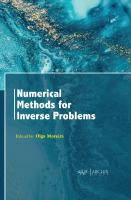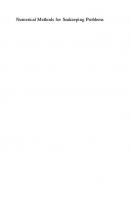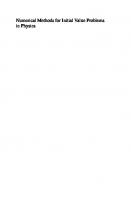The Numerical Method of Characteristics for Hyperbolic Problems in Three Independent Variables
A.R.C. technical report no. 2615, dated September 1948, on numerical sokution of partial differential equations in three
126 62 568KB
English Pages [15] Year 1952
2615_001
2615_002
2615_003
2615_004
2615_005
2615_006
2615_007
2615_008
2615_009
2615_010
2615_011
2615_012
2615_013
2615_014
2615_015
Recommend Papers
File loading please wait...
Citation preview
R.
« M. No. 2615 (1It 767)
A.R.C. Technical Report
SUPPLY AERONAUTICAL RESEARCH COUNCIL REPORTS AND MEMORANDA
The Numerical Method of Characteristics for Hyperbolic Problems in Three Independent Variables By C. K.
THORNHILL,
M.A. (Oxon.)
Crown Copyright Reserved
LONDON: HER MAJESTY'S STATIONERY OFFICE PRICE
195 2 35. 6d.
NE:T
The Numerical Method of Characteristics for Hyperbolic Problems in Three Independent Variables By
C. K. THORNHILL, M.A. (Oxon.) COMMUNICATED BY THE PRINCIPAL DIRECTOR OF SCIENTIFIC MINISTRY OF SUPPLY
Reports and Memoranda No. 2615* September, 1948 Introduction and Summary.--Recent advances in electronic computing devices suggest that it may soon be feasible to attempt numerical solutions of problems involving three independent variables. In this paper, preliminary consideration is given to the extension of the numerical method of characteristics for hyperbolic equations to the case of three independent variables. A general quasi-linear second order partial differential equation in three variables is first considered, and the characteristic surfaces and curves are derived, together with the differential relations which hold along them. It is shown that numerical integration should be possible along the faces or edges of a hexahedral grid. The equations are developed in more detail for two special cases of compressible flow, namely steady isentropic supersonic flow in three-dimensional space, and unsteady flow in two dimensions.
1. The General Quasi-linear Second-order Partial Differential Equation in Three Independent Variables.-Consider first the general second-order partial differential equation, linear in the second derivatives, which may be written,
allPll
+ a22P22 + aaaPaa + 2a2aP2a + 2aaiPai + 2a12P12
- l
=
0,
or, using the summation convention, i ,j _ 1, 2, 3}, {aij - al'i where, the independent variable ep being a function of aij Pil' - l
=
oep . o~ep A = -;;-, Al' = 0 0 etc., ox, Xi Xl' and ail" l, are functions of ep,
Xi,
=
Xi
(1.02)
(Xl' X 2 ,
xa)-space, which may be defined, in terms of two
(IX, fJ) ;
and let it be supposed that the values of ep,
* A.R.E. (22a07)
Report 29/48.
Xl' X 2 , Xa,
A, only.
Consider next any surface' in parameters IX, fJ, by Xi
(1.01)
0,
(1.03)
Pr, P2'
Pa are known at all points of this surface.
Received 14th October, 1948.
1 A
Then, at all points on this surface, these known values must satisfy the six relations
p.
OPi =
orx
~~i
lJ
Pij
=
OXi
(1.04)
~i
(1.05)
orx
of which only five are independent. relations) .
(The summation convention is used in these and subsequent
Thus any five of these equations, together with the original partial differential equation pij at all points of the surface
(1.01), may be solved to give values of the second derivatives (1.03), in terms of known quantities.
The solution is best obtained as follows: Write, (1.06)
where ('Ijl, is the alternating tensor, so that L b L 2, La are thus proportional to the direction cosines of the normal at (Xl' X 2 , X s ) to the surface (1.03). The six relations (1.04) and (1.05) may then be written, ('jkl
Pit
•
Lk
-~ oA arx
OXj _ a(J
op,
OXj
a{3 art. =
X
ij
say
(1.07)
where, it should be noted, Of these nine relations, again only five are independent, by virtue of the four identities, (1.08)
and
o.
X; =
(1.09)
Thus, combining any independent five of the relations (1.07) with the original partial differential equation (1.01), the solution for Pij is obtained in the form, II ij
p. =
(1.10)
e
lJ
where except for sign, the six IIi/s and e are the seven determinants of the sixth order of a matrix with six rows and seven columns. Using, for example, the relations in Xu, X 12 , X a1 , X 2a, X a2, the matrix is, I
-a;
0
0
0
0
La
L3
0
0
0
-L 1
0
0
-L 3
0
L2
0
0
0
L1
0
0
0
-L 2
0
0
-L 1
0
au
a 22
a 33
2a23
L3 0 2a a 1 2a 12 2
Xu Xu X 21 X 23 X 32 1
(1.11)
Thus, if e does not vanish, the second derivatives pij at all points of the surface (1.03) are determined, and, proceeding in a similar manner, it may be shown that the third and higher order derivatives of 1> are also determinable, provided the same quantity e does not vanish. In this case Cauchy's problem is solved, and 1> is determined uniquely, if it is holomorphic, or, as Kowalewski has shown, if the given values of 1>, PI' P2,Pa on the curve (1.03) are analytic and regular. (cf. Ref. 1). Suppose, however, that at all points of the surface (1.03) the quantity e vanishes. It follows from (1.10) that all the IIi/s must also vanish if a non-trivial solution exists, and this introduces just the one further condition necessary to make the matrix (1.11) of rank 5. The condition, e
=
0, is, in full, (1.12)
i.e., the condition that the normal (L I , L 2 , La) to the surface (1.03) should lie on a cone of the second degree, which is real, unless the quadratic form (1.12) is either positive definite or negative definite.
Defining
the quadratic form (1.12) is positive definite if, [cf., for example, Ref. 2J Ll i > 0, Ll 2 and negative definite if, Ll i
0,
Ll a > 0,
x 2 , xa)-space. The characteristic conoids associated with the points of an arbitrary curve have an envelope, consisting in general, of two sheets. Thus two general characteristic surfaces pass through any arbitrary curve in (Xl' x 2, x3)-space. The relations between the general characteristic surfaces, the characteristic cones, conoids, and the bi-characteristic curves, are illustrated in Fig. 1. The condition that all the lli/s should vanish simultaneously with e , is given by the vanishing of anyone of these quantities, e.g., by
1112
== anL1X13 -
a22L2X23
-+ a33(L2X32
- LaX n ) (1.21)
This differential relation, which holds along any characteristic surface satisfying (1.12) at every point, is sufficient, with (1.12), in the hyperbolic case when the characteristic surfaces are real, to develop a numerical solution starting from a given open boundary surface along which the conditions of a problem are known. In place of the characteristic grid, familiar in hyperbolic problems with only two independent variables, there are now two possible types of network along which numerical integration may be carried out-a hexahedral network of general characteristic surfaces, or a hexahedral network of hi-characteristic curves. In each case, the known solution of the problem, already determined at three points, PI' P 2 , P 3 , leads to the solution at a fourth point P 4 • The' units' of such networks are shown in Figs. 2 and 3.
4
In Fig. 2 the rear branch of the characteristic conoid at P 4 cuts the plane P 1P2Pa in a curve inscribed to the triangle P1P2Pa, and the three faces P 4P2Pa, P 4P aP1, P 4P1P2 of the tetrahedron P1P2PaP4 are segments of general characteristic surfaces, which, in a sufficiently small ' unit' may be taken as plane sections. Associated with each of these faces there are two relations, corresponding to (1.12) and (1.21), i.e., six relations in all, and these six relations, together with the known conditions at PI' P 2, P, are sufficient to determine the three unknown space coordinates of P 4, and the values of PI' P 2, P, at P 4. There are three other' units', similar to that in Fig. 2, associated with the three points PI' P 2, P a, given by the points P 4 whose characteristic conoids intersect the plane P IP2Pa in curves escribed to the triangle P1P2Pa• In Fig. 3, the rear branch of the characteristic conoid at P 4 cuts the plane P IP2Pa in a curve circumscribed to the triangle P IP2P a, and the three edges P 4PI, P 4P2, P 4P a of the tetrahedron P IP2PaP4 are segments of bi-characteristic curves, which, in a sufficiently small' unit' may be taken as linear segments. Again, associated with each of these three .edges there are two relations corresponding to (1.12) and (1.21), i.e., six relations in all, and these are sufficient together with the information known at PI' P 2 • P a to determine the six essential unknown quantities at P 4 • !
In theory then, it should be possible to integrate numerically in a progressive manner, along a hexahedral grid of one of the above types, starting from the known conditions of a problem on an open boundary surface. The complexity of such a numerical process, hitherto beyond contemplation, may become tractable soon by the rapid computational facilities afforded by new electronic machines.
2. Steady Supersonic Compressible-flow in Three-dimensional Space.-·With cartesian coordinates (xv X 2 , X a), let the components of fluid velocity be u1a" u 2as , u-a, respectively, where as is a constant speed, and consider the case of adiabatic irrotational flow. Then a velocity potential 1> may be defined so that,
u,
01> =Pi = -a . Xi
(2.01)
The speed of sound, aa., is given by
dp dp
= yp _ a2a 2 p -
(2.02)
s
a~d Bernoulli's equation, obtained by integrating the equations of steady motion of the fluid, grves
-
y
+1
2 (y -
1)
(2.03)
if the constant speed as is chosen to be the local speed of sound in the fluid when the velocity is sonic; i.e., p 12 + P22 + Pa 2 = 1 when a = 1. Thus where
(22a07)
(2.04) A,2
=
y+ ~
may be defined so that,
Pl == -04> ox == P2 ==
~~
U
== v 2
04> == - {U +2 Pa == at
2
v
+
fdpP} -
(3.01)
where the speed of sound a satisfies (3.02) The equations of motion are then automatically satisfied, and the equation of continuity reduces to the potential equation, (3.03) (Pl2- a2) Pu + (P2 2 - a2) P22 + Paa + 2P2Pg2 + 2PlPla + 2PlP2 P12 == O. Hence, by (1.12) the normal (L l, L 2, La) to a characteristic surface satisfies (u2 - a 2) L l2 + (v2 - a 2) L 22 + La2 + 2vL 2La + 2uL gLl + 2uvL lL 2 =
O.
(3.04)
The conditions (1.14) and (1.15) for this to be a definite quadratic form are never satisfied, and it reduces to a perfect square only when a == O. Thus the potential equation (3.03) is always hyperbolic at every point. The characteristic cone (1.18) at the point (xo, Yo, to) is, (x - XO)2 + (y - yo)2 + (u2 + v2 - a2)(t - t o)2
- 2u(x - xo)(t - to) - 2v(y - Yo)(t - to) == 0
(3.05)
which has the property that it cuts the plane in the circle,
t == to
+ ..
whose centre is the point (xo -f
UT,
Yo
+ VT,
to
+ T)
and whose radius is ax.
The equation of the characteristic conoid is, (dx -
U
dW
+ (dy
-- v dW
== 9
(a dW ..
(3.06)
and the differential relation 1712 = 0 is, 1712
= (U 2
a 2 ) L 1X 13
-
2vL 2 X 22
(V 2
-
-
a 2 ) L 2X23
-I- L 2X3 2
-
L 3Xll
2uL 1Xll = O.
-
(3.07)
Fig. 5 illustrates the characteristic geometry of this particular flow. normal (L l • L 2 , L 3 ) to a characteristic surface staisfies (uL l
Now, from (3.04) the
-I- 7'L 2 -I- 1- 3)2 =: a 2(L 1 2 -I- L 2 2 )
(3.08)
and may, therefore, be expressed parametrically by u sin b
-~- 7'
cos
/j
(3.09)
-I- a
The corresponding hi-characteristic direction is, (11 -I- a sin
0,
v
-I- a cos
b,
1).
(3.10)
Hence if the bi-characteristic curves are chosen as the parametric curves fJ = constant, and the curves of intersection with the planes t =~ constant, are chosen as the parametric curves o: = constant, the following relations may be taken, for any characteristic surface /j = /j(oc, fJ)
oxj ooc
=
ltja -I- sin
/j
I I
oyj ooc
=
vja -I- cos
/j
~
(3.11)
I
and
otj ooc
=
1ja
oxj a(J
=
cos
ayj ofJ
=
-
otj 0(J
=
0 .
J /j
sin
}
/j
(3.12)
Then L, = sin 15ja L 2 = cos 15ja L3 = -
(uja sin
/j
-I- vja cos 15 -I-
J°
Substituting these values, the differential relation II 12 of the parameters, oc, fJ, to
(a -I- u cos (5)( ouj OCl -
=
(3.13)
ultimately reduces, for this choice
ovj oP) - v sin 15 (ovj OCl -I- ouj oP)
-I- 2aj(y - 1). sin b oajoCl -I- 2j(y - 1). (v -I- a cos (5) aajafJ
=
0,
(3.14)
whilst the identity (1.09) reduces to, cos 15 .( ouj ooc -
avj 0(J) - sin 15( ovj aoc -I- ouj oP) -I- 2j(y - 1) 10
~;
=
O.
(3.15)
Relations (3.14) and (3.15) combine to give, finally ou _ { ort. ou { o{3
+
OV} I 2 {. 1 SIll b o{3 T y OV} Ort.
+
y
2
oa a;
oa} + cos b o{3
{ oa 1 cos 0 Ort. -
.
SIll
=
(3.16)
0
oa} b aji = O...
(3.17)
These relations would form the basis of numerical computation along. a hexahedral grid, as suggested in Section 1. For or
v
=
0,
b
u
=
0,
b = 0,
=
n/2, respec ti vely,
relations (3.16) and (3.17) reduce to the familiar integrals for unsteady flow in one dimension,
or
u
±
v
±
y 2a _ 1
2a
y -
1
. . dx = constant, a Iong t h e ch aracteristics dt =
(u
±
a)
=
(v
±
a).
=
constant, along the characteristics ddYt
REFERENCES No.
1
Title, etc.
Author
J. Hadamard
2 W. S. Burnside and A. W. Panton
"Lecons sur la propagation des ondes et les equations de l'hydrodynamique '. Paris, Hermann, 1903. The Theory of Equations, Vol. II.
11
Longmans, Green & Co.
CHARACTERISTIC CONOIOS
CHARACTERISTIC CONE
PI ARBITRARY CURVE IN SPACE GENERAL CHARACTERISTIC SURFACES THROUGH ARBITRARY CURVE FIG. 1.
FIG. 2.
FIG. 3.
12
blRECTION OF FLOW
(A, Pz, P3) Xz BI-CHARACTERISTIC
(~t 11, al2 , PZ,a/3 tP3) d(3 ; 0
...
(pz 13 - P3.{Z, 1'31,- P/~, Prlz - PZi,) dd.::o
CHARACTERISTIC NORMAL (L,
12 '3) 4.
FIG.
t (u,t', I) BI-CHARACTERISTIC
I:=------,k--/-::::::::.
x
(u.ta
SIN S,1tto.r:os,s,I)
d (3 eO
FIG. (22307)
Wt. 15-680
Kg
1/52
F. M. & S
PRINTED IN GREAT BRITAIN
13
R• .& M. No. 26n5 (H,161)
A.R.C. Technical Report
1----------------Publications of the Aeronautical Research Council
1
-------------------,---~---
ANNUAL TECHNICAL REPORTS OF THE AERONAUTICAL RESEARCH COUNCIL (BOUND VOLUMES)1934-35 VoL 1. Aerodynamics. Ou; of print. Vol. II. Seaplanes, Structures, Engines, Materials, etc. 40s. (40s. Sd.) 1935-36 Vol. I. Aerodynamics. 30s. (30s. 7d.) Vol. II. Structures, Flutter, Engines, Seaplanes, etc. 30s. (30s. 7d.) 1936 Vol. I. Aerodynamics General, Performance, Airscrews, Flutter and Spinning. 4)s. (40s. 9d.) Vol. II. Stability and Control, Structures, Seaplanes, Engines, etc. 50s. (50s. 10d.) 1937 Vol. 1. Aerodynamics General, Performance, Airscrews, Flutter and Spinning. 40s. (40s. lOd.) Vol. II. Stability and Control, Structures, Seaplanes, Engines, etc. 60s. (61s.) 19~~8 Vol. I. Aerodynamics General, Performance, Airscrews, 50s. (51s.) Vol. II. Stability and Control, Flutter, Structures, Seaplanes, Wind Tunnels, Materials. 30s. (30s. 9d.) 1939 Vol. 1. Aerodynamics General, Performance, Airscrews, Engines. 50s. (50s. lId.) Vol. II. Stability and Control, Flutter and Vibration, Instruments, Structures, Seaplanes, etc. 63s. (64s. 2d.) 1940 Aero and Hydrodynamics, Aerofoils, Airscrews, Engines, Flutter, Icing, Stability and Control, Structures, and a miscellaneous section. 50s. (51s.) Certain other reports proper to the 1940 volume will subseq'umtly be included in a separate volume. ANNUAL REPORTS OF THE AEIWNAUTICAL RESEARCH COUNCII.1933-34 Is. 6d. (Is. Sd.) 1934-35 Is. Gd. (Is. Sd.) April I, 1935 to December 31, 1936. 4s. (4s. 4d.) 1937 2s. (2s. 2d.) 1938 Is. 6d. (Is. Sd.) 1939-48 3s. (3s. 2d.) INDEX TO ALL REPORTS AND MEMORANDA PUBLISHED IN THE ANNUAL TECHNICAL REPORTS, AND SEPARATELYApril, 1950 R. & M. No. 2600. 2s. sz, (2s. 7ld.) INDEXES TO THE TECHNICAL REPORTS OF THE AERONAUTICAL RESEARCH COUNCILDecember 1, 1936 - June 30, 1939. R. & M. No. 1850. Is. 3d. (Is. 4td.) ~·uly I, 1939 - June 30, 1945. R. & M. No. 1950. Is. (Is. ltd.) ~·uly 1, 1945 - June 30, 1946. R. 81: M. No. 2050. Is. (Is. lid.) July 1, 1946 - December 31, 1946. R. 81: M. No. 2150. Is. 3d. (Is. 4id.) January I, 1947 - June 30, 1947. R. & M. No. 2250. Is, 3d. (Is. 4td.) Prices in brackets include postage.
Obtainable from
HER MAJESTY'S STATIONERY OFFICE York House, Kingsway, LONDON, W.C 2 423 Oxford Street, LONDON, w.l P.O. Box 569, LONDON, s.a.l 13a Castle Street, EDINBURGH, 21St. Andrew's Crescent, CARDIFF 39 King Street, MANCHESTER, 2 Tower Lane, IlRISTOL, 1 2 Edmund Street, BIRMINGHAM, 3 80 Chichester Street, BELFAST
or through any bookseller. ___
~
••_".
..,-J
S.O. Code No. 23.2615










